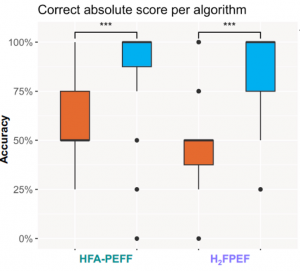Summary on Retinal Vascular Changes in Heart Failure with Preserved Ejection Fraction Using Optical Coherence Tomography Angiography
Disclaimer before you continue: The content of this page is generated to facilitate the interpretation of research to individuals interested in cardiovascular healthcare. The content is not intended for personal medical advice. Summaries and interpretations of the authors of a study do not reflect my professional opinion. Research often takes years to decades before results are developed enough to implement in clinical healthcare because new findings need to be extensively validated before we consider them safe enough for individual patients. Always consult your own professional healthcare provider for medical advice.
The original article that is summarized on this page can be found here: https://doi.org/10.3390/jcm13071892
If #HFpEF is a systemic syndrome with microvascular dysfunction, we should find indicators in 👁️
We assessed 👀 in detail using #OCTAngio & found several differences compared to control 👥.
See video: pic.twitter.com/LS9zwFUAFo#openaccess #CardioTwitter #heartfailure
— Jerremy Weerts, MD (@JerremyWeerts) April 1, 2024
Background information
Heart failure is a heart condition characterized by the inability of the heart to supply enough oxygen rich blood to body organs. Consequently, patients with heart failure experience symptoms such as shortness of breath during physical activities or fatigue. Half of all individuals with heart failure have heart failure with preserved ejection fraction (HFpEF). Preserved ejection fraction means that the pump function of the left chamber of the heart is working normally. Rather, heart failure is present due to diastolic dysfunction and a stiffened left chamber of the heart, causing an inability to fill appropriately. Patients with HFpEF often have other cardiovascular diseases or risk factors such as hypertension, diabetes mellitus, atrial fibrillation, or impaired kidney function. As such, it is thought that HFpEF is a syndrome that occurs throughout the body. It is also thought that that adverse alterations in the smallest blood vessels (the microcirculation) play a key role in the development from healthy to HFpEF.
Methods used by the researchers
A study was performed in 22 patients with HFpEF and 24 control individuals without heart failure. The investigators studied the back of the eye (the retina) of all participants using a special eye camera. This camera allowed to visualize and quantify the microcirculation around the yellow oval spot of the eye (the macula).

An example image how the microcirculation looks (yellow and green vessels) around the macula of the eye.
Results of the study
The characteristics of patients with HFpEF and control individuals were different. For example, patients were around 74 years old and control individuals were around 68 years old. This is reflected on in the Discussion section.
Patients showed several differences in their retina compared to control individuals; 1) a smaller amount of vessels per surface area (smaller density), 2) thinner layers that are rich in neurons, and 3) smaller total retinal volume. An example of how a smaller vessel density would look in the eye is shown below. It is exaggerated for clarity.

It was also found that smaller total retinal volume may be related to the severity of heart failure in patients with HFpEF.
Discussion by researchers of the study
The researchers concluded that the present study suggests that patients with HFpEF have microvascular and neuronal retinal changes compared to individuals without heart failure. They state the word suggested because the study is of small size, and the two groups had different characteristics. Still, it is reported that the group differences are larger than what would be expected based on the characteristics alone based on previous research. The researchers could not formally test this reasoning in their own study because of the small group sizes.
Reflection and open questions
My personal reflection on this study is biased because I have co-designed and conducted the study. The study was a proof-of-principle to show that the eye can be a promising window to look for microcirculation changes in HFpEF. The results should be seen in this light, and not lead to firm conclusions. It is interesting to see that both retinal vascular and neuronal changes may occur in HFpEF. It remains to be seen if these retinal changes remain robust when analyses are performed in control individuals with the same characteristics. Also, it will be worthwhile to know how the retinal changes relate to microvascular changes in other areas of the body, such as the skin or the heart. Moreover, it will be important to know if therapies that improve microcirculation throughout the body also improve the microvascular changes observed in the present study. The latter will show if the observed differences can be relevant for clinical practice in the end.



